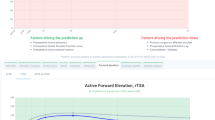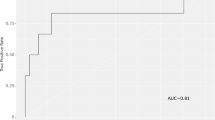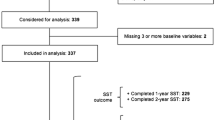Abstract
The aim of the present study was to individuate and compare specific machine learning algorithms that could predict postoperative anterior elevation score after reverse shoulder arthroplasty surgery at different time points. Data from 105 patients who underwent reverse shoulder arthroplasty at the same institute have been collected with the purpose of generating algorithms which could predict the target. Twenty-eight features were extracted and applied to two different machine learning techniques: Linear regression and support vector regression (SVR). These two techniques were also compared in order to define to most faithfully predictive. Using the extracted features, the SVR algorithm resulted in a mean absolute error (MAE) of 11.6° and a classification accuracy (PCC) of 0.88 on the test-set. Linear regression, instead, resulted in a MAE of 13.0° and a PCC of 0.85 on the test-set. Our machine learning study demonstrates that machine learning could provide high predictive algorithms for anterior elevation after reverse shoulder arthroplasty. The differential analysis between the utilized techniques showed higher accuracy in prediction for the support vector regression.
Level of Evidence III: Retrospective cohort comparison; Computer Modeling.







Similar content being viewed by others
References
Currie G, Hawk KE, Rohren E et al (2019) Machine learning and deep learning in medical imaging: intelligent imaging. J Med Imag Radiat Sci 50:477–487. https://doi.org/10.1016/j.jmir.2019.09.005
Handelman GS, Kok HK, Chandra RV et al (2018) eDoctor: machine learning and the future of medicine. J Intern Med 284:603–619. https://doi.org/10.1111/joim.12822
Jordan MI, Mitchell TM (2015) Machine learning: trends, perspectives, and prospects. Science 349:255–260. https://doi.org/10.1126/science.aaa8415
Weiss J, Kuusisto F, Boyd K et al (2015) Machine learning for treatment assignment: improving individualized risk attribution. AMIA Annu Symp Proc 2015:1306–1315
Cabitza F, Locoro A, Banfi G (2018) Machine learning in orthopedics: a literature review. Front Bioeng Biotechnol 6:75. https://doi.org/10.3389/fbioe.2018.00075
Lalehzarian SP, Gowd AK, Liu JN (2021) Machine learning in orthopaedic surgery. WJO 12(685):699. https://doi.org/10.5312/wjo.v12.i9.685
Myers TG, Ramkumar PN, Ricciardi BF et al (2020) Artificial intelligence and orthopaedics: an introduction for clinicians. J Bone Joint Surg 102:830–840. https://doi.org/10.2106/JBJS.19.01128
Gowd AK, Agarwalla A, Amin NH et al (2019) Construct validation of machine learning in the prediction of short-term postoperative complications following total shoulder arthroplasty. J Shoulder Elbow Surg 28:e410–e421. https://doi.org/10.1016/j.jse.2019.05.017
Roche C, Kumar V, Overman S et al (2021) Validation of a machine learning–derived clinical metric to quantify outcomes after total shoulder arthroplasty. J Shoulder Elbow Surg 30:2211–2224. https://doi.org/10.1016/j.jse.2021.01.021
Saenz G, de Tejada M, Escobar A, Bilbao A et al (2014) A prospective study of the association of patient expectations with changes in health-related quality of life outcomes, following total joint replacement. BMC Musculoskelet Disord 15:248. https://doi.org/10.1186/1471-2474-15-248
Sáenz G, de Tejada M, Escobar A, Herrera C et al (2010) Patient expectations and health-related quality of life outcomes following total joint replacement. Value in Health 13:447–454. https://doi.org/10.1111/j.1524-4733.2009.00685.x
Palazzo C, Jourdan C, Descamps S et al (2014) Determinants of satisfaction 1 year after total hip arthroplasty: the role of expectations fulfilment. BMC Musculoskelet Disord 15:53. https://doi.org/10.1186/1471-2474-15-53
Franceschetti E, Giovannetti de Sanctis E, Gregori P et al (2021) Return to sport after reverse total shoulder arthroplasty is highly frequent: a systematic review. Journal of ISAKOS 6:363–366. https://doi.org/10.1136/jisakos-2020-000581
Chalmers PN, Gupta AK, Rahman Z et al (2014) Predictors of early complications of total shoulder arthroplasty. J Arthroplasty 29:856–860. https://doi.org/10.1016/j.arth.2013.07.002
Farng E, Zingmond D, Krenek L, SooHoo NF (2011) Factors predicting complication rates after primary shoulder arthroplasty. J Shoulder Elbow Surg 20:557–563. https://doi.org/10.1016/j.jse.2010.11.005
Friedman RJ, Eichinger J, Schoch B et al (2019) Preoperative parameters that predict postoperative patient-reported outcome measures and range of motion with anatomic and reverse total shoulder arthroplasty. JSES Open Access 3:266–272. https://doi.org/10.1016/j.jses.2019.09.010
Kohan EM, Hendy BA, Kowal LL et al (2022) Mid- to long-term outcomes of augmented and nonaugmented anatomic shoulder arthroplasty in Walch B3 glenoids. J Shoulder Elbow Surg 31:S103–S109. https://doi.org/10.1016/j.jse.2021.12.016
Leschinger T, Raiss P, Loew M, Zeifang F (2017) Total shoulder arthroplasty: risk factors for intraoperative and postoperative complications in patients with primary arthritis. J Shoulder Elbow Surg 26:e71–e77. https://doi.org/10.1016/j.jse.2016.08.001
Matsen FA, Russ SM, Vu PT et al (2016) What factors are predictive of patient-reported outcomes? A prospective study of 337 shoulder arthroplasties. Clin Orthop Relat Res 474:2496–2510. https://doi.org/10.1007/s11999-016-4990-1
Fontana MA, Lyman S, Sarker GK et al (2019) Can machine learning algorithms predict which patients will achieve minimally clinically important differences from total joint arthroplasty? Clin Orthop Relat Res 477:1267–1279. https://doi.org/10.1097/CORR.0000000000000687
Twiggs JG, Wakelin EA, Fritsch BA et al (2019) Clinical and statistical validation of a probabilistic prediction tool of total knee arthroplasty outcome. J Arthroplasty 34:2624–2631. https://doi.org/10.1016/j.arth.2019.06.007
Kumar V, Roche C, Overman S et al (2020) What is the accuracy of three different machine learning techniques to predict clinical outcomes after shoulder arthroplasty? Clin Orthop Relat Res 478:2351–2363. https://doi.org/10.1097/CORR.0000000000001263
Kumar V, Roche C, Overman S et al (2021) Using machine learning to predict clinical outcomes after shoulder arthroplasty with a minimal feature set. J Shoulder Elbow Surg 30:e225–e236. https://doi.org/10.1016/j.jse.2020.07.042
Kumar V, Schoch BS, Allen C et al (2022) Using machine learning to predict internal rotation after anatomic and reverse total shoulder arthroplasty. J Shoulder Elbow Surg 31:e234–e245. https://doi.org/10.1016/j.jse.2021.10.032
Erickson BJ, Chalmers PN, Denard P et al (2021) Does commercially available shoulder arthroplasty preoperative planning software agree with surgeon measurements of version, inclination, and subluxation? J Shoulder Elbow Surg 30:413–420. https://doi.org/10.1016/j.jse.2020.05.027
Funding
None.
Author information
Authors and Affiliations
Corresponding author
Ethics declarations
Conflict of interest
The authors declare that they have no conflict of interest.
Additional information
Publisher's Note
Springer Nature remains neutral with regard to jurisdictional claims in published maps and institutional affiliations.
Rights and permissions
Springer Nature or its licensor (e.g. a society or other partner) holds exclusive rights to this article under a publishing agreement with the author(s) or other rightsholder(s); author self-archiving of the accepted manuscript version of this article is solely governed by the terms of such publishing agreement and applicable law.
About this article
Cite this article
Franceschetti, E., Gregori, P., De Giorgi, S. et al. Machine learning can predict anterior elevation after reverse total shoulder arthroplasty: A new tool for daily outpatient clinic?. Musculoskelet Surg (2024). https://doi.org/10.1007/s12306-023-00811-z
Received:
Accepted:
Published:
DOI: https://doi.org/10.1007/s12306-023-00811-z




